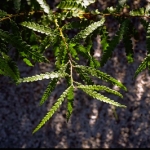| Common Name: |
Sweet Fern |
| Botanical Name: |
Comptonia peregrina |
| Genus: |
Comptonia |
| Family: |
Myricaceae |
| Native Location: |
E USA |
| Cultivation: |
Well-drained to dry, acid soil in sun or partial shade. |
| Propagation: |
By seed sown when ripe; by removal of rooted suckers in spring; by layering in spring. Difficult to transplant successfully. |
| Harvest: |
Leaves are cut in early summer and dried for use in infusions. |
| Height: |
1-2m (3-6ft) |
| :Width |
60cm-1.2m (2-4ft) |
| Hardiness: |
Z2-7 |
| Parts Used: |
Leaves |
| Properties: |
An aromatic, astringent herb that controls bleeding and discharges. |
| Medicinal Uses: |
Internally for diarrhea, vaginal discharge, dysentery, and vomiting of blood. Externally for mino hemorrhage, rashes, stings. |
| Culinary Uses: |
Fresh or dried leaves make a pleasant herb tea. |
| Bibliography: |
Encylopedia of Herbs by Deni Brown Copyright ©: 1995, 2001 Dorling Kindersley Limited pg 177
|

